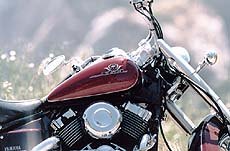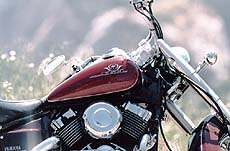Church Of MO – 1998 Yamaha V-Star 650 Classic

Cruisers don’t always get the attention they deserve here at MO. Part of the reason is the racing background of most of the staff here. So when we sent Mark Miller, professional AMA Formula X-Treme racer, and current Isle of Man TT competitor to evaluate a cruiser — the 1998 Yamaha V-Star 650 Classic — we knew he’d come back with something out of the ordinary. Miller was used to getting his knee down at triple digit speeds aboard his YZF-R1, but while reviewing the 650 Classic he also saw some parallels between the two. Sounds crazy, but considering the breadth of motorcycles, cruisers included, Miller has ridden, the idea didn’t seem so far fetched after all. In this Church of MO edition, let’s take a look at how the 16 year-old V-Star and R1 worlds collide.
1998 Yamaha V-Star 650 Classic
By Mark Miller Jun. 19, 1998
LOS ANGELES, June, 1998 — Over the past couple years, I’ve been invited to action model just about every conceivable Japanese cruiser on the market. Now I have been given an opportunity to ride Yamaha’s new 650 V-Star Classic.
If you were to visit any of your local motorcycle dealers today and browse through a few of the brochures, chances are the rider you’ll be looking at most often is this funny-looking, cruiser wanna-be guy — me. From a Kawasaki Vulcan to a Honda Aero, I’ve ridden them all. Who would have thought a professional roadracer would also have some fairly good knowledge of street cruisers as well? I’m happy to say that I’ve been fortunate.
How did the new V-Star stack up to the competition? In my opinion, many of the cruisers on the market are very similar in design, performance and appearance. So, to make this review just a little more interesting, I’m going to compare this Yamaha motorcycle to the Yamaha motorcycle I’m currently racing around the country in the AMA Formula Extreme Series: the YZF1000-R1.
Huh?
True, these bikes come from different ends of the spectrum regarding what they were designed to do, but I think there is still very much that can be learned by putting these two bikes up against each other in a bit of a mock shoot-out.
Luckily, I brought my girlfriend, Tammi, along for the ride and I said something like this: “I think I’m just going to ride this thing home after all. Would you mind driving the truck back by yourself? I would hate to throw my back out or something trying to load it right before the next race.” Little did she know I just wanted to mount this cool, sparkling motorcycle right away, not to mention be able to split lanes all the way home instead of sit in L.A.’s rush-hour traffic.
I fired up the V-Star and took off. The first thing I noticed when slicing through traffic were the very wide handlebars. They felt wider than ones on other cruisers I had ridden recently. I had to be really careful not to slap too many car mirrors on my jaunt home; you never know if one of the cars you hit belongs to someone that happens to live just down the street from you.
On the other hand, the R1 is skinny enough that you would have to be a pretty lame rider to actually hit a car mirror while splitting lanes, not that it would matter much, since the driver would not be able to make out the blur that just flew by.
Put Tammi — or, for that matter, your girlfriend — on the back of the R1 and it’s a different story. Don’t stop for sandwiches if you don’t want to hear the whining. Tammi was not a happy camper on the back of that token slab of foam, especially when her knees are practically higher than her ears. In another setting, this is not an altogether undesirable position, but for a day of carving a canyon road on your shiny R1 sportbike, I think Tammi would normally opt to remain back at the ranch.
The $11,000 R1, on the other hand, can do 120+ mph in only the third of its six gears, so I believe it goes without saying that any freeway cruising speeds would not begin to labor the R1’s power plant. And who cares what the mileage is like on the R1?
The four-piston front-brake caliper performs with excellence on the V-Star, and the rear drum brake works equally well. One fun thing a cruiser does better than any sportbike is this: You can back these things sideways going into corners, and the chassis will settle in, just like a flat-track bike, giving you tons of feel. My neighbors are going to be very happy when I have to return the V-Star to Yamaha. I keep painting black skid-graffiti marks everywhere I go in the neighborhood. One could almost track my every daily move by just following the skid marks. Sorry, but it’s just too fun.
I would be more leary of backing an R1 around street corners if I were any less experienced a rider than I am. The chassis, wheelbase, and steering head angle on an aggressive sportbike like an R1 can make things very twitchy when sliding into a corner, full opposite lock, particularly if you don’t know what to do with the clutch, the downshifts, the engine rpm, the front brake, and finally the rear brake. Plus, every cop within six blocks would probably end up seeing you doing it and, if you have my kind of luck, he’d want to make an example out of you. The only other nitpick I have against the V-Star is that I don’t care for having to look so far down to get a read on the tank-mounted speedometer. Granted, the speedo is set-up in classic, retro style, giving the front-end a clean look, but I prefer a set-up found a Honda Magna or a Sportster — straight above the headlight and between the bars.
The R1’s speedo is an LED apparatus that shows you exactly how fast you are going by displaying the actual number. It’s still connected and operational on both my race bikes. The fastest I’ve measured it (I keep trying to remember to look down at it when I’m on the fastest straights) was 158 mph. I’d be curious to know if it has a topped-out reading, like 190 mph. I’ll let you know.
Overall, the Yamaha 650 V-Star Classic is a well-rounded, affordable, fun bike to ride. It has good ground clearance, a good gear box, comfortable seat, powerful brakes, and a price that won’t require that you get a second mortgage to acquire one like some of the American cruisers. And I’m willing to bet that it will probably continue to run like new well after you’ve overhauled your ‘Made-in-the-USA’ product a couple times.
Sure, it will lose out on the racetrack or canyon road against the YZF-R1, but with the right riders on each bike, they may be closer to each other than you might think. Tammi loved the V-Star so much she even refused to go with me back to Marina del Rey to return the bike. If that isn’t a strong recommendation, I don’t know what is.
Dyno Charts Specifications:
Manufacturer: Yamaha Model: V-Star ClassicPrice: ,899.00Engine: air-cooled, SOHC, V-TwinBore x stroke: 91 x 63 mmDisplacement: 40 cubic inches Carburetion: Two BSC 28 mm carburtorsTransmission: Five SpeedWheelbase: 64 in (1656 mm)Seat height: 28 in (711 mm)Fuel capacity: 4.2 gallons (15.9L)Claimed dry weight: 496 lbs (225 kg)

Troy's been riding motorcycles and writing about them since 2006, getting his start at Rider Magazine. From there, he moved to Sport Rider Magazine before finally landing at Motorcycle.com in 2011. A lifelong gearhead who didn't fully immerse himself in motorcycles until his teenage years, Troy's interests have always been in technology, performance, and going fast. Naturally, racing was the perfect avenue to combine all three. Troy has been racing nearly as long as he's been riding and has competed at the AMA national level. He's also won multiple club races throughout the country, culminating in a Utah Sport Bike Association championship in 2011. He has been invited as a guest instructor for the Yamaha Champions Riding School, and when he's not out riding, he's either wrenching on bikes or watching MotoGP.
More by Troy Siahaan














































Comments
Join the conversation
LOL - poor Tammi....